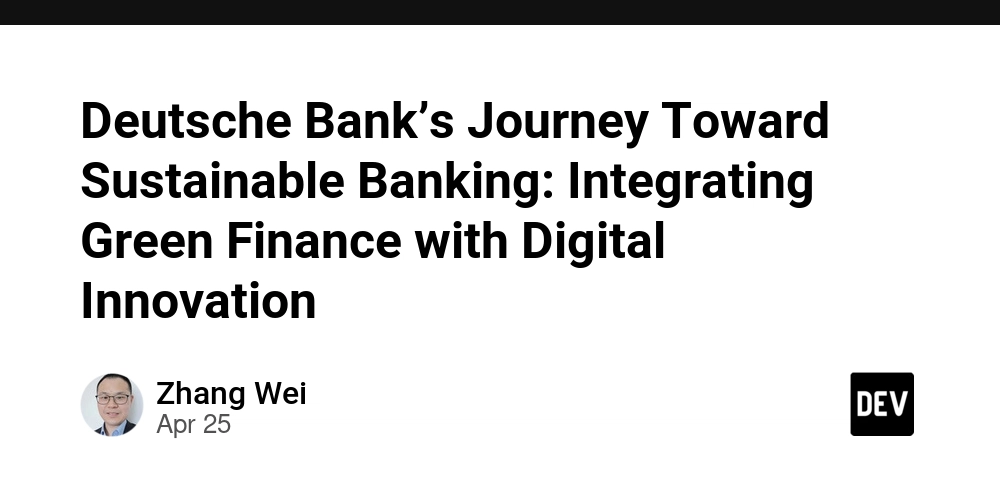Deutsche Bank’s Journey Toward Sustainable Banking: Integrating Green Finance with Digital Innovation
Abstract: In this post we examine Deutsche Bank’s evolving sustainability strategy within the banking sector. We explore the integration of green finance, digital technology, and open-source principles. By analyzing the bank’s initiatives, obstacles, and future prospects, we gain insights into how traditional institutions can pivot to sustainable practices. In addition, we discuss related topics such as sustainable blockchain practices, regulatory challenges, and innovative funding methods. This article is meant to educate technical and financial audiences on combining digital innovation with environmental responsibility. Introduction Traditional banking faces increasing pressure to address environmental and social challenges. Deutsche Bank is at the forefront of this transformation. Through a series of initiatives aimed at reducing its carbon footprint and enhancing environmental, social, and governance (ESG) metrics, the bank is transforming its operations and products to meet modern sustainability demands. This post reviews Deutsche Bank’s path to sustainable banking and examines how the integration of digital innovation, responsible finance, and open-source technologies can pave the way for a greener financial future. Banks today must navigate complex regulation, changing investor sentiments, and new market expectations. Sustainable banking is not simply an ethical requirement but a business imperative. With the rise of sustainable blockchain practices and digital identity platforms, Deutsche Bank’s strategy demonstrates how technology and finance can work together to serve environmental interests. For further details, check out the Deutsche Bank's Path to Sustainable Banking: A Case Study. Background and Context History of Sustainable Banking Sustainable banking has emerged as part of a broader movement in finance where financial institutions integrate ESG criteria into their business models. Over the past decade, rising concerns about climate change and environmental degradation have spurred a demand for more responsible investment practices. Definitions and Ecosystem Sustainable Banking: Banking practices that incorporate ESG factors into risk assessment, investment, and day-to-day operations. Green Finance: Financial products and services designed to support environmentally sustainable projects, such as green bonds. ESG (Environmental, Social, Governance): Criteria to assess environmental impact, social responsibility, and effective governance within a company. Digital Innovation in Finance: Use of digital technologies, including data analytics and blockchain, to enhance operational efficiency and transparency. Financial institutions like Deutsche Bank are exploring sustainable banking as a way to secure long-term profitability while positively impacting society. Government regulators, investors, and clients now expect transparency and tangible environmental commitment. Core Concepts and Features Deutsche Bank’s sustainable approach involves several core concepts: 1. Reducing the Carbon Footprint The bank is targeting net-zero emissions by 2050 through initiatives that reduce the environmental impact of operations. Key actions include: Green Operations: Investing in energy-efficient infrastructure and facilities. Sustainable Supply Chain: Prioritizing eco-friendly procurement and partner selection. 2. Advancing Sustainable Finance Deutsche Bank’s sustainable finance initiatives are designed to channel investments into projects that foster environmental and social benefits: Green Bonds and Loans: Issuance of bonds and loans that fund renewable energy, waste reduction, and other green projects. ESG-Centric Investments: Incorporating ESG criteria in the evaluation process to identify investments with sustainable impact. 3. Enhancing Stakeholder Engagement The bank actively engages its employees, investors, and clients to build a culture of sustainability: Employee Engagement: Training programs and workshops to raise awareness on green initiatives. Collaborative Partnerships: Working closely with regulatory bodies and international stakeholders to share best practices. 4. Embracing Digital Innovation Digital tools enhance Deutsche Bank’s efforts to monitor, report, and improve their ESG performance: Data Analytics: Using data to track ESG performance in real time. Digital Investments Platforms: Developing tools for green investments that integrate with sustainable blockchain practices. Learn more about blockchain and digital identity. Table 1 – Key Sustainable Banking Initiatives Initiative Name Focus Area Key Action Items Carbon Reduction Measures Green Operations Energy efficiency, renewable energy investments Sustainable Finance Green Bonds and ESG Issuing green bonds, ESG-centric risk assessment Stakeholder Engagement Training & Collab

Abstract:
In this post we examine Deutsche Bank’s evolving sustainability strategy within the banking sector. We explore the integration of green finance, digital technology, and open-source principles. By analyzing the bank’s initiatives, obstacles, and future prospects, we gain insights into how traditional institutions can pivot to sustainable practices. In addition, we discuss related topics such as sustainable blockchain practices, regulatory challenges, and innovative funding methods. This article is meant to educate technical and financial audiences on combining digital innovation with environmental responsibility.
Introduction
Traditional banking faces increasing pressure to address environmental and social challenges. Deutsche Bank is at the forefront of this transformation. Through a series of initiatives aimed at reducing its carbon footprint and enhancing environmental, social, and governance (ESG) metrics, the bank is transforming its operations and products to meet modern sustainability demands. This post reviews Deutsche Bank’s path to sustainable banking and examines how the integration of digital innovation, responsible finance, and open-source technologies can pave the way for a greener financial future.
Banks today must navigate complex regulation, changing investor sentiments, and new market expectations. Sustainable banking is not simply an ethical requirement but a business imperative. With the rise of sustainable blockchain practices and digital identity platforms, Deutsche Bank’s strategy demonstrates how technology and finance can work together to serve environmental interests. For further details, check out the Deutsche Bank's Path to Sustainable Banking: A Case Study.
Background and Context
History of Sustainable Banking
Sustainable banking has emerged as part of a broader movement in finance where financial institutions integrate ESG criteria into their business models. Over the past decade, rising concerns about climate change and environmental degradation have spurred a demand for more responsible investment practices.
Definitions and Ecosystem
- Sustainable Banking: Banking practices that incorporate ESG factors into risk assessment, investment, and day-to-day operations.
- Green Finance: Financial products and services designed to support environmentally sustainable projects, such as green bonds.
- ESG (Environmental, Social, Governance): Criteria to assess environmental impact, social responsibility, and effective governance within a company.
- Digital Innovation in Finance: Use of digital technologies, including data analytics and blockchain, to enhance operational efficiency and transparency.
Financial institutions like Deutsche Bank are exploring sustainable banking as a way to secure long-term profitability while positively impacting society. Government regulators, investors, and clients now expect transparency and tangible environmental commitment.
Core Concepts and Features
Deutsche Bank’s sustainable approach involves several core concepts:
1. Reducing the Carbon Footprint
The bank is targeting net-zero emissions by 2050 through initiatives that reduce the environmental impact of operations. Key actions include:
- Green Operations: Investing in energy-efficient infrastructure and facilities.
- Sustainable Supply Chain: Prioritizing eco-friendly procurement and partner selection.
2. Advancing Sustainable Finance
Deutsche Bank’s sustainable finance initiatives are designed to channel investments into projects that foster environmental and social benefits:
- Green Bonds and Loans: Issuance of bonds and loans that fund renewable energy, waste reduction, and other green projects.
- ESG-Centric Investments: Incorporating ESG criteria in the evaluation process to identify investments with sustainable impact.
3. Enhancing Stakeholder Engagement
The bank actively engages its employees, investors, and clients to build a culture of sustainability:
- Employee Engagement: Training programs and workshops to raise awareness on green initiatives.
- Collaborative Partnerships: Working closely with regulatory bodies and international stakeholders to share best practices.
4. Embracing Digital Innovation
Digital tools enhance Deutsche Bank’s efforts to monitor, report, and improve their ESG performance:
- Data Analytics: Using data to track ESG performance in real time.
- Digital Investments Platforms: Developing tools for green investments that integrate with sustainable blockchain practices. Learn more about blockchain and digital identity.
Table 1 – Key Sustainable Banking Initiatives
| Initiative Name | Focus Area | Key Action Items |
|---|---|---|
| Carbon Reduction Measures | Green Operations | Energy efficiency, renewable energy investments |
| Sustainable Finance | Green Bonds and ESG | Issuing green bonds, ESG-centric risk assessment |
| Stakeholder Engagement | Training & Collaboration | Employee training, multi-stakeholder partnerships |
| Digital Innovation | Data Analytics & Platforms | ESG data tracking, digital investment products |
5. Regulatory Adaptation and Market Demand
- Regulatory Compliance: New government regulations require emissions reductions. For deeper insights, explore blockchain regulation.
- Investor Influence: Clients and investors increasingly demand ESG compliance, which shapes the bank’s strategic decisions.
Applications and Use Cases
Deutsche Bank’s sustainable approach offers lessons that can be replicated across various financial and tech sectors. Here are three practical examples:
Use Case 1: Green Bonds Issuance
Deutsche Bank’s issuance of green bonds has set a benchmark for other banks. These bonds fund projects such as renewable energy installations and sustainable infrastructure. This model attracts ESG-focused investors who look for long-term, environmentally positive outcomes.
Key Benefits:
- Attracting ESG Investors: Increased trust among investors who prioritize sustainability.
- Positive Environmental Impact: Funding low-carbon projects helps reduce overall emissions.
- Enhanced Transparency: Regular reporting on bond usage and impact.
Use Case 2: Digital Platforms for Sustainable Investments
By leveraging digital technologies and data analytics, Deutsche Bank offers investment platforms that showcase green projects for individual and institutional investors. These platforms combine traditional investment models with innovative digital identity verification to ensure compliance and transparency.
Core Features Include:
- Real-Time ESG Reporting: Offering investors immediate insights into their sustainability performance.
- User-Friendly Interface: Simplifying complex data trends into actionable insights for all user groups.
- Integration with Blockchain: For enhanced security and traceability, refer to blockchain technology for open source security.
Use Case 3: Collaborative Stakeholder Models in Sustainable Finance
Deutsche Bank collaborates with governments and international agencies to shape a future-oriented sustainable financial ecosystem. This includes creating forums and platforms to exchange ideas and implement new regulatory guidelines for sustainable finance.
Notable Effects:
- Enhanced Industry Standards: Improved ESG reporting standards via cross-industry dialogue.
- Circular Economy Support: Funding initiatives that reduce waste and promote reuse.
- Global Collaboration: Partnerships with international organizations to drive sustainable finance globally.
Challenges and Limitations
Despite the tremendous potential, sustainable banking also faces notable challenges:
- Profitability vs. Sustainability: Balancing short-term earnings with long-term environmental goals can be complex. Financial returns must align with sustainable outcomes.
- Regulatory Complexities: Varying regulations across regions make it challenging to maintain a consistent sustainability framework.
- Measuring Impact: ESG metrics can be vague or inconsistent, making it harder to compare performance across projects.
- Technology Gaps: The integration of advanced digital solutions, such as data analytics and blockchain, requires substantial investment and technical expertise.
Bullet List – Main Challenges for Sustainable Banking:
- Competing Objectives: Balancing immediate profit with long-term sustainability.
- Regulatory Fragmentation: Inconsistent global standards and implementation.
- Measurement Difficulties: Lack of standardized, transparent ESG metrics.
- Technological Barriers: Bridging gaps between existing systems and emerging digital solutions.
For additional context on digital asset security and challenges, consider insights from Safeguarding the Blockchain: The Future of Digital Asset Security.
Future Outlook and Innovations
The evolution of sustainable banking points to several future trends and innovations:
Emerging Trends
- Circular Economy Integration: Financial institutes might increasingly support projects that reduce waste and promote recycling, paving the way for a circular economy model.
- Enhanced Transparency: The development of robust ESG data analytics will lead to standardized, real-time impact reporting.
- Innovative Financial Products: New products tailored to sustainability, such as impact investment funds and blockchain-based green financing models, could disrupt traditional banking models.
Innovations on the Horizon
- Advanced Data Analytics: More sophisticated analytic tools can offer better ESG tracking and reporting.
- Blockchain Integration: Secure, decentralized ledger technologies will further enhance transparency and accountability in sustainable finance. For instance, check out blockchain and environmental impact to see how digital ledgers aid sustainability.
- Collaborative Funding Models: New models including decentralized financing and open-source funding can help smaller, innovative startups scale sustainable projects. See Unleashing the Power of Gitcoin and Quadratic Funding for related ideas.
Impact of Open Source and Alternative Funding
Deutsche Bank’s strategy resonates beyond finance into the realm of open-source development and alternative funding models. The rise of open-source funding models, as discussed in Open Source Funding for Maintenance, has parallels with the bank’s sustainability journey. This convergence shows that both green finance and open-source innovation share the goal of long-term, sustainable progress.
Summary
Deutsche Bank’s journey toward sustainable banking illustrates a transformative model for the traditional financial sector. The bank’s holistic approach includes:
- Reducing Carbon Footprint: Through green operations and a sustainable supply chain.
- Adopting Sustainable Finance: Issuing green bonds and integrating ESG criteria in all business practices.
- Engaging Stakeholders: Training employees and collaborating internationally.
- Leveraging Digital Innovation: Implementing cutting-edge data analytics and blockchain solutions.
These initiatives are supported by regulatory adaptation and market demand shifts. However, challenges such as balancing short-term profitability with long-term sustainability, handling regulatory complexities, and overcoming technological gaps remain.
Looking forward, the future of sustainable banking is bright. Innovations in data analytics, blockchain technology, and collaborative funding models are likely to drive further integration of environmental responsibility with financial operations. This paradigm shift not only strengthens the financial industry’s resilience but can also serve as a model for other sectors to follow.
For further reading on sustainable blockchain practices, visit sustainable blockchain practices and explore related insights on blockchain and open-source funding.
Additionally, for a broader perspective on open-source funding, please read the following Dev.to posts:
- Exploring the Cyberwarfare Potential of Lil Pudgy's NFTs
- Unleashing the Power of Gitcoin and Quadratic Funding
- Open Source Funding For Maintenance
Deutsche Bank’s strategy demonstrates that sustainability is not only a regulatory or ethical obligation—it is an innovation driver that aligns digital technologies, financial services, and environmental stewardship. Embracing these innovations and overcoming present challenges will shape the evolution of banking in the future.
Conclusion
In summary, the pivot toward sustainable banking by Deutsche Bank is both a proactive business decision and a response to global environmental challenges. By investing in digital innovation, reducing its carbon footprint, and promoting green finance, Deutsche Bank not only sets a higher standard in the financial industry but also paves the way for future sustainability initiatives. As banks and tech companies converge on topics like blockchain integration, open-source funding, and advanced ESG analytics, the financial industry’s future will increasingly be defined by sustainable and innovative practices.
Through this comprehensive case study, we see that sustainable banking is evolving from a niche concern into a cornerstone of modern finance. This journey, while filled with challenges such as balancing short-term profits with long-term goals and navigating complex regulations, offers immense opportunities for reshaping financial landscapes in a way that benefits both business and society.
Ultimately, Deutsche Bank’s path underscores the importance of blending technological innovation with a commitment to environmental care—an approach that can inspire many other institutions and developers to forge responsible, forward-thinking economic models.
Stay informed, stay innovative, and join the journey toward a greener, more resilient financial future.









































































